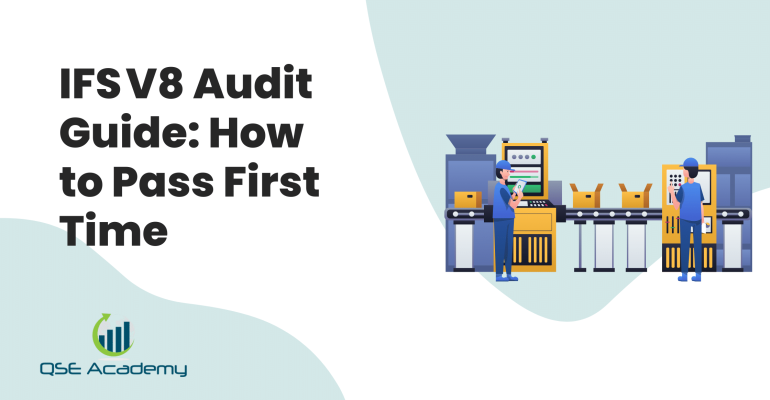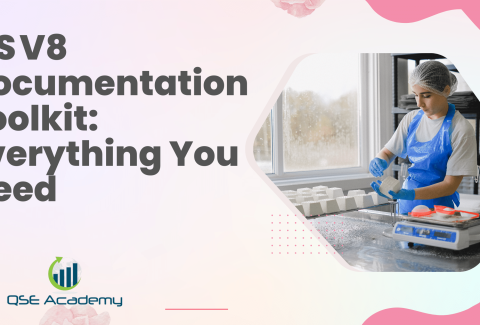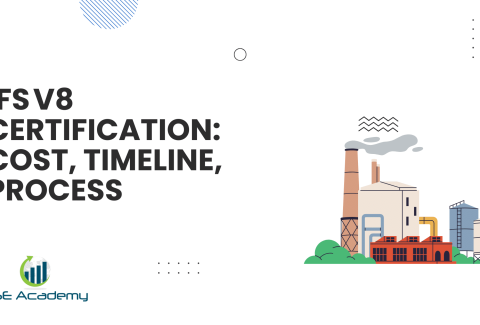IFS V8 Audit Guide: How to Pass First Time
Last Updated on November 19, 2025 by Melissa Lazaro
Your Roadmap to Passing the IFS V8 Audit on the First Attempt
If you’re preparing for an IFS V8 audit, clarity and structure matter. Over the years supporting organizations through IFS, BRCGS, and FSSC certification, I’ve seen two patterns: teams that follow a systematic approach pass confidently, while those who rely on last-minute preparation struggle with uncertainty, rushed documentation updates, and stressed audit responses.
This guide is built to simplify the process. It gives you the practical steps to prepare effectively, understand expectations, train your team, and build the habits needed to demonstrate compliance consistently—not temporarily.
One example stands out: a facility transitioning to IFS for the first time shifted from chaotic reactive prep to structured readiness. By focusing on internal audits, operator competency, and documentation consistency, they not only passed first attempt—they achieved a high grade with zero Majors. The difference was preparation backed by understanding, not just activity.
This article will walk you through every essential area so you can confidently approach your IFS V8 audit the first time.
Understanding the IFS V8 Requirements — What Changed and Why It Matters
IFS V8 isn’t simply a revision—it sharpens expectations on everyday operational execution, risk-based controls, labeling accuracy, food safety culture, and traceability performance. Policies and written compliance are no longer enough. Auditors expect alignment between what is documented and what is happening in real time.
Many teams focus only on reading the standard, but the real value comes from interpreting what it means operationally.
A helpful mindset is:
Policies explain the intent. Procedures explain how. Records prove it happened. The facility demonstrates it’s lived.
 Building a Strong QMS Foundation — Documentation, Records, and Version Control
Building a Strong QMS Foundation — Documentation, Records, and Version Control
Your QMS is the backbone of your audit. It must be complete, controlled, accessible, and aligned with current processes. Auditors look for structure—not stacks of paper.
Focus on:
- Controlled SOPs with clear ownership
- Revision tracking and approval signatures
- Retention rules aligned with IFS requirements
- Point-of-use accessibility—not hidden in files
One gap that appears frequently is outdated documents on the production floor even though newer versions exist in digital folders. This signals inconsistency and weak document control.
Pro Tip: Build a simple document register with revision dates, responsible owners, and status to maintain control.
Internal Audits and Gap Assessment — Your First-Line Audit Rehearsal
An effective internal audit predicts certification outcomes. Treat it as a rehearsal, not as a compliance formality.
Your internal audit should verify:
- Documentation accuracy
- Operator understanding
- Records completeness
- Process execution
- Alignment with IFS V8 clauses
Start on the production floor and validate upward toward documentation. It gives a realistic picture of execution, not just what’s written.
Many facilities make the mistake of auditing only paperwork. The strongest approach blends interviews, observation, sampling, and evidence review.
Training & Competency — Preparing a Confident and Aligned Team
IFS V8 expects evidence of competence, not only training attendance.
Operators should be able to communicate:
- What tasks they perform
- Why those tasks matter for safety or quality
- What actions to take if something goes wrong
Short, consistent training sessions work better than one large annual event. Pair them with verbal checks, mock interviews, and observation-based validation to ensure understanding.
Confidence—not memorization—helps during audits.
Operational Readiness — Bringing the Requirements to Life on the Floor
Auditors spend most of their time observing on the floor. Everything must show control and consistency—from hygiene behaviors to allergen segregation.
Key focus areas include:
- CCP monitoring
- Cleaning validation
- Label control
- Allergen handling
- Calibration status
- Housekeeping and visual standards
Treat the production floor as a living demonstration of your system—not a separate environment from documentation.
Simple visual controls and line-side instructions help operators execute accurately and consistently.
Traceability, Recall, and Supplier Control — High-Impact Focus Areas
Traceability and recall performance remain major decision points in an IFS audit. The expectation is completeness, accuracy, and speed.
Teams should be able to trace:
- Raw materials
- Intermediate batches
- Packaging
- Finished goods
- Distribution records
Supplier control also plays a significant role. Approval files must include clear criteria, documented risk assessments, and current supplier evidence.
Consistency between what is purchased and who is officially approved is essential.
Audit day doesn’t need to feel stressful when preparation is solid. Organization, calm communication, and readiness go a long way.
Tips that help:
- Keep evidence organized and accessible
- Answer what’s asked—clearly and simply
- Demonstrate transparency when gaps appear
- Assign a support team (runner, document lead, floor escort)
Auditors evaluate control, confidence, and consistency—not performance theatrics.
Understanding Scoring & Findings — KO, Major, Minor and What They Mean
IFS V8 uses a scoring scale to assess conformity. Understanding how findings are graded helps you position your response and maintain certification eligibility.
Brief overview:
- KO failures can block certification
- Major NCs indicate significant breakdown
- Minor NCs identify small but meaningful gaps
- Scoring influences the final grade and follow-up requirements
Treat every internal finding as an opportunity to improve—not just a requirement to correct.
Corrective Actions and Continuous Improvement — Closing the Loop
When findings occur, a structured corrective action approach demonstrates maturity.
A complete response includes:
- Root cause analysis
- Corrective action
- Evidence of implementation
- Verification of effectiveness
Consistency over time matters more than speed.
Continuous improvement ties everything together. Review audit trends, track recurring themes, and integrate system enhancements into routine performance reviews.
FAQs — Common Questions About Passing IFS V8 First Time
How long does preparation typically take?
Timelines depend on system maturity, documentation quality, and operational discipline.
Do we need a digital QMS to pass?
No, but digital systems often reduce errors and increase record availability.
Is the process different for unannounced audits?
Requirements are the same—expectations around daily readiness are higher.
Conclusion — Final Thoughts and Next Step
Passing the IFS V8 audit first time requires clarity, structure, and consistent execution—not rushed preparation. When documentation aligns with daily practice, operators understand their role, and internal reviews are realistic rather than administrative, the audit process becomes predictable and manageable.
A strong system isn’t built during audit week—it’s built into everyday practice.
If you’re ready for the next step, the full audit preparation toolkit can support you in applying everything outlined here to your facility.
Melissa Lavaro is a seasoned ISO consultant and an enthusiastic advocate for quality management standards. With a rich experience in conducting audits and providing consultancy services, Melissa specializes in helping organizations implement and adapt to ISO standards. Her passion for quality management is evident in her hands-on approach and deep understanding of the regulatory frameworks. Melissa’s expertise and energetic commitment make her a sought-after consultant, dedicated to elevating organizational compliance and performance through practical, insightful guidance.








